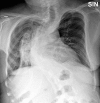Long-Term Response to Vasoactive Treatment in a Case of Kyphoscoliosis-Associated Pulmonary Hypertension
- PMID: 31606732
- PMCID: PMC6808734
- DOI: 10.12659/AJCR.917154
Long-Term Response to Vasoactive Treatment in a Case of Kyphoscoliosis-Associated Pulmonary Hypertension
Abstract
BACKGROUND Kyphoscoliosis is an anatomical deformity of the spine often accompanied by an array of respiratory complications, pulmonary hypertension being among the most severe ones. At present, evidence-based treatment options for kyphoscoliosis-related pulmonary hypertension remain limited to the correction of hypoxemia through ventilatory support and long-term oxygenation. CASE REPORT We report a case of a 61-year-old female with severe kyphoscoliosis-related pulmonary hypertension who was admitted to a university hospital in September 2018 due to progressive dyspnea and respiratory failure. She was diagnosed with pulmonary hypertension in 2016 and had been on endothelin receptor antagonist (ambrisentan) and oxygen therapy ever since. Upon admission, the patient presented with severe depression of peripheral oxygen saturation (SpO₂ at 75%). The patient declined further treatment hours after hospitalization, despite optimized supportive oxygen therapy. Ambrisentan was discontinued and replaced by inhaled iloprost. Over the course of the next 4 days, the patient showed symptomatic improvement and was discharged on Day 5. Right heart catheterization follow-up in February 2019 showed no worsening in pulmonary hemodynamic parameters compared to the time of initial diagnosis. CONCLUSIONS Managing the respiratory decline in kyphoscoliosis-related pulmonary hypertension can be challenging since these patients tend to deteriorate despite current treatment options. Our case reports on the use of vasoactive agents as a safe and effective treatment option in addition to established therapeutic regimen.
Conflict of interest statement
None.
Figures
References
-
- Bergofsky EH, Turino GM, Fishman AP. Cardiorespiratory failure in kyphoscoliosis. Medicine (Baltimore) 1959;38:263–317. - PubMed
-
- Krieger J, Sforza E, Apprill M, et al. Pulmonary hypertension, hypoxemia, and hypercapnia in obstructive sleep apnea patients. Chest. 1989;96(4):729–37. - PubMed
-
- Galiè N, Humbert M, Vachiery JL, et al. 2015 ESC/ERS Guidelines for the diagnosis and treatment of pulmonary hypertension: The Joint Task Force for the Diagnosis and Treatment of Pulmonary Hypertension of the European Society of Cardiology (ESC) and the European Respiratory Society (ERS) : Endorsed by: Association for European Paediatric and Congenital Cardiology (AEPC), International Society for Heart and Lung Transplantation (ISHLT) Eur Heart J. 2016;37:67–119. - PubMed
-
- Held M, Walthelm J, Baron S, Roth C, Jany B. Functional impact of pulmonary hypertension due to hypoventilation and changes under noninvasive ventilation. Eur Respir J. 2014;43:156–65. - PubMed
Publication types
MeSH terms
Substances
LinkOut - more resources
Full Text Sources
Medical


